An Analysis to Identify the Key Factors in Power System Planning: The Case of Mexico
Abstract
1. Introduction
- The analysis integrates elements to obtain energy shortage, congestion in transmission network, regional reserve margin performance, power plant installation regions that could significantly impact emission reduction, and technologies with higher/lower plant factors.
- Disaggregated data are included for different parameters such as generation cost, availability factors, or regional transmission capacity.
- The case study demonstrates the importance of disaggregating data for the identification of vulnerabilities in decarbonization scenarios of a Power Electrical System.
- The general ED is extended to consider the characteristics of the SEN using four sets of variables and parameters (technologies, generation regions, consumption regions, and time steps).
- The model programming runs under the open-source Python Optimization Modeling (PYOMO) platform, which is freely available in the repository https://github.com/IhanKaydarin/Multi-regional-time-step-and-technology-economic-dispatch, accessed on 30 September 2024.
2. Methodology
- Characterization of electrical power system;
- Mathematical modeling;
- Data collection;
- Model programming;
- Identification of vulnerabilities.
2.1. Characterization of Electrical Power System
2.2. Mathematical Modeling
2.2.1. Assumptions
2.2.2. Objective Function
2.2.3. Restrictions
2.3. Data Collection
2.4. Model Programming
2.5. Identification of Vulnerabilities
- Hourly energy shortage: If any restrictions are unmet, they can be determined. There are diverse reasons why this situation could occur, such as the low availability of intermittent technologies, congestion or limited transmission capacity, or the region’s lack of self-supply capacity. However, it is possible to overcome this inconvenience by proposing an additional technology with the highest generation cost so that when it is dispatched, the quantity, hours, and region of missing energy can be known.
- Hours of congestion on transmission lines: This aspect is obtained by counting the hours in which the energy transmitted from one region to another is equal to or greater than 90% of the link capacity. This calculation is shown in Equation (6).The links with the highest number of hours of congestion represent the regions with the most significant external power dependence, high potential to increase the national transmission network, and areas of opportunity to reduce generation costs.
- Regional reserve margin performance: This factor identifies the regions vulnerable to changes in the generation availability of the power units installed in the region. In addition, those regions that meet the indicative values established in the reliability policy are identified. The regional reserve margin is determined through Equation (7):
- Regions that can install power plants that could significantly reduce emissions must be identified: The plants with the highest emission factor and the highest generation must be identified. However, it is essential to remember that proposing to install a new plant with a low emission factor requires a more exhaustive analysis than those described in this research.
- Technologies with a higher/lower capacity factor: This parameter provides valuable information on the units essential for energy supply and the underutilized plants.
3. Case Study
3.1. Characterization of SEN
3.2. Mathematical Modeling
3.2.1. Assumptions for SEN 2025
- International interconnections were not considered.
- Availability factors were averaged for thermoelectric, combined cycle, coal-fired, turbogas, internal combustion, fluidized bed, geothermal, bioenergy, cogeneration, and nuclear technologies.
- The total installed capacity for each technology in each region was used.
- The generation cost considers the levelized fuel cost, the regional increase in fuel costs, and the operation and maintenance cost.
- Availability factors for thermal technologies were annual averages.
- Seasons of unavailability due to preventive maintenance of the plants were not considered.
3.2.2. Objective Function of SEN 2025
3.2.3. Restrictions of SEN 2025
- In agreement with Equation (2), the first restriction outlined in Equation (9) represents the balance between energy production and demand by consumption region. It assesses the total energy produced across the 9 generation regions using each of the 13 technologies. Parameter (MWh) denotes the energy demand in each region of the SEN for every hour:
- Equation (11) defines the maximum transmission capacity (MWh) between the 9 regions, as indicated by Equation (4). The electricity produced by each generation region and transmitted to each consumption region during each hour must not exceed the maximum capacity of the links connecting these 9 regions:
3.3. Data Collection
4. Results and Discussion
4.1. Results of SEN 2025
4.1.1. Hourly Energy Shortage
4.1.2. Hours of Congestion on Transmission Lines
4.1.3. Regional Reserve Margin Performance
4.1.4. Regions Where Power Plants Are Installed That Could Significantly Impact Reducing Emissions Must Be Identified
4.1.5. Technologies with Higher/Lower Capacity Factor
5. Conclusions
- There was no power shortage during the simulated year, indicating adequate capacity to meet demand.
- The minimum reserve margin was 8% of total capacity, suggesting sufficiency.
- High congestion occurred in the Noreste–Oriental, Norte–Occidental, Noroeste–Occidental, and Noreste–Occidental links, exceeding 5000 h, highlighting an opportunity to diversify power plant capacity.
- Central and Noreste regions had the highest emissions and contributed most to the global emission factor.
- Combined cycle, biomass, geothermal, and nuclear technologies achieved capacity factors of 75% or higher.
Author Contributions
Funding
Data Availability Statement
Conflicts of Interest
Appendix A. Glossary of Terms
| Type | Index | Description |
|---|---|---|
| Sets | i ∈ I | The index for technology |
| g ∈ G | The index for generation regions | |
| c ∈ C | The index for consumption regions | |
| t ∈ T | The index for time step | |
| Parameters and variables | x | Energy that technology i installed in generation region g |
| sends to consumption region c during hour t (MWh) | ||
| c | Generation cost of technology i installed in generation | |
| region g to send electricity to consumption region c during | ||
| hour t (USD/MWh) | ||
| D | Energy demand in each region for each hour (MWh) | |
| fd | Availability factor of each technology in each generation | |
| region for each hour (fraction) | ||
| F | Installed capacity of each technology in each generation | |
| region (MW) | ||
| MCT | Maximum capacity that each link can transmit | |
| between generation and consumption regions (MWh) |
References
- Intergovernmental Panel on Climate Change (IPCC). Climate Change and Land: IPCC Special Report on Climate Change, Desertification, Land Degradation, Sustainable Land Management, Food Security, and Greenhouse Gas Fluxes in Terrestrial Ecosystems; Cambridge University Press: Cambridge, UK, 2022. [Google Scholar] [CrossRef]
- Intergovernmental Panel on Climate Change (IPCC). Climate Change 2021: The Physical Science Basis; Cambridge University Press: Cambridge, UK, 2021. [Google Scholar] [CrossRef]
- Intergovernmental Panel on Climate Change (IPCC). Climate Change 2022: Impacts, Adaptation and Vulnerability; Cambridge University Press: Cambridge, UK, 2022. [Google Scholar] [CrossRef]
- Advani, N.K. Assessing species vulnerability to climate change, and implementing practical solutions. Biol. Conserv. 2023, 286, 110284. [Google Scholar] [CrossRef]
- Kim, M.J.; Hong, J.B.; Han, I.S.; Lee, J.S.; Kim, D.H. Vulnerability assessment of Korean fisheries to climate change. Mar. Policy 2023, 155, 105735. [Google Scholar] [CrossRef]
- Tee Lewis, P.G.; Chiu, W.A.; Nasser, E.; Proville, J.; Barone, A.; Danforth, C.; Kim, B.; Prozzi, J.; Craft, E. Characterizing vulnerabilities to climate change across the United States. Environ. Int. 2023, 172, 107772. [Google Scholar] [CrossRef]
- Adeagbo, O.; Bamire, A.; Akinola, A.; Adeagbo, A.; Oluwole, T.; Ojedokun, O.; Ojo, T.; Kassem, H.; Emenike, C. The level of adoption of multiple climate change adaptation strategies: Evidence from smallholder maize farmers in Southwest Nigeria. Sci. Afr. 2023, 22, e01971. [Google Scholar] [CrossRef]
- Rathnayaka, B.; Robert, D.; Siriwardana, C.; Adikariwattage, V.; Pasindu, H.; Setunge, S.; Amaratunga, D. Identifying and prioritizing climate change adaptation measures in the context of electricity, transportation and water infrastructure: A case study. Int. J. Disaster Risk Reduct. 2023, 99, 104093. [Google Scholar] [CrossRef]
- Sedtha, S.; Pramanik, M.; Szabo, S.; Wilson, K.; Park, K.S. Climate change perception and adaptation strategies to multiple climatic hazards: Evidence from the northeast of Thailand. Environ. Dev. 2023, 48, 100906. [Google Scholar] [CrossRef]
- Muzammil, M.; Zahid, A.; Farooq, U.; Saddique, N.; Breuer, L. Climate change adaptation strategies for sustainable water management in the Indus basin of Pakistan. Sci. Total Environ. 2023, 878, 163143. [Google Scholar] [CrossRef]
- United Nations Framework Convention on Climate Change (UNFCCC). Adoption of the Paris Agreement. 2015. Available online: https://www.un.org/en/development/desa/population/migration/generalassembly/docs/globalcompact/FCCC_CP_2015_10_Add.1.pdf (accessed on 10 September 2024).
- Bashir, M.F.; MA, B.; Hussain, H.I.; Shahbaz, M.; Koca, K.; Shahzadi, I. Evaluating environmental commitments to COP21 and the role of economic complexity, renewable energy, financial development, urbanization, and energy innovation: Empirical evidence from the RCEP countries. Renew. Energy 2022, 184, 541–550. [Google Scholar] [CrossRef]
- Singh, K.; Meena, R.S.; Kumar, S.; Dhyani, S.; Sheoran, S.; Singh, H.M.; Pathak, V.V.; Khalid, Z.; Singh, A.; Chopra, K.; et al. India’s renewable energy research and policies to phase down coal: Success after Paris agreement and possibilities post-Glasgow Climate Pact. Biomass Bioenergy 2023, 177, 106944. [Google Scholar] [CrossRef]
- Yang, G.; Zha, D.; Cao, D.; Zhang, G. Time for a change: Rethinking the global renewable energy transition from the Sustainable Development Goals and the Paris Climate Agreement. Innovation 2024, 5, 100582. [Google Scholar] [CrossRef]
- Umar, M.; Ji, X.; Kirikkaleli, D.; Xu, Q. COP21 Roadmap: Do innovation, financial development, and transportation infrastructure matter for environmental sustainability in China? J. Environ. Manag. 2020, 271, 111026. [Google Scholar] [CrossRef]
- Crnčec, D.; Penca, J.; Lovec, M. The COVID-19 pandemic and the EU: From a sustainable energy transition to a green transition? Energy Policy 2023, 175, 113453. [Google Scholar] [CrossRef]
- Tian, J.; Yu, L.; Xue, R.; Zhuang, S.; Shan, Y. Global low-carbon energy transition in the post-COVID-19 era. Appl. Energy 2022, 307, 118205. [Google Scholar] [CrossRef]
- Mišík, M.; Nosko, A. Post-pandemic lessons for EU energy and climate policy after the Russian invasion of Ukraine: Introduction to a special issue on EU green recovery in the post-Covid-19 period. Energy Policy 2023, 177, 113546. [Google Scholar] [CrossRef]
- Żuk, P.; Żuk, P. National energy security or acceleration of transition? Energy policy after the war in Ukraine. Joule 2022, 6, 709–712. [Google Scholar] [CrossRef]
- Xin, B.; Zhang, M. Evolutionary game on international energy trade under the Russia-Ukraine conflict. Energy Econ. 2023, 125, 106827. [Google Scholar] [CrossRef]
- Ślusarczyk, B.; Chłąd, M.; Michałek, J.; Dacko-Pikiewicz, Z.; Androniceanu, A. Strategies for supplying enterprises with energy in the context of changing coal prices on the Polish market—The effect of the war in Ukraine. Resour. Policy 2023, 85, 104028. [Google Scholar] [CrossRef]
- Liu, W.; Chen, X.; Zhang, J. The Russia-Ukraine conflict and the automotive energy transition: Empirical evidence from China. Energy 2023, 284, 128562. [Google Scholar] [CrossRef]
- Cui, L.; Yue, S.; Nghiem, X.H.; Duan, M. Exploring the risk and economic vulnerability of global energy supply chain interruption in the context of Russo-Ukrainian war. Resour. Policy 2023, 81, 103373. [Google Scholar] [CrossRef]
- Gobierno de México. Contribución Prevista y Determinada a Nivel Nacional (INDC) de México. 2015. Available online: https://www.gob.mx/cms/uploads/attachment/file/162974/2015_indc_esp.pdf (accessed on 11 September 2024).
- Gobierno de México—Instituto Nacional de Ecología y Cambio Climático (INECC). Inventario Nacional de Emisiones de Gases y Compuestos de Efecto Invernadero. 2024. Available online: https://www.gob.mx/inecc/acciones-y-programas/inventario-nacional-de-emisiones-de-gases-y-compuestos-de-efecto-invernadero (accessed on 11 September 2024).
- Procuraduría Federal de Protección al Ambiente (PROFEPA). Ley General de Cambio Climático. 2024. Available online: https://www.profepa.gob.mx/innovaportal/file/6583/1/ley_general_de_cambio_climatico.pdf (accessed on 11 September 2024).
- Diario Oficial de la Federación (DOF). Decreto por el que se expide la Ley de Transición Energética. 2015. Available online: https://dof.gob.mx/nota_detalle.php?codigo=5421295&fecha=24/12/2015#gsc.tab=0 (accessed on 11 September 2024).
- Secretaría de Energía (SENER). Programa de Desarrollo del Sistema Eléctrico Nacional 2024–2038. 2024. Available online: https://www.gob.mx/sener/articulos/programa-de-desarrollo-del-sistema-electrico-nacional-2024-2038 (accessed on 11 September 2024).
- Santillán Vera, M.; García Manrique, L.; Rodríguez Peña, I.; De La Vega Navarro, A. Drivers of electricity GHG emissions and the role of natural gas in mexican energy transition. Energy Policy 2023, 173. [Google Scholar] [CrossRef]
- Diezmartínez, C. Clean energy transition in Mexico: Policy recommendations for the deployment of energy storage technologies. Renew. Sustain. Energy Rev. 2021, 135, 110407. [Google Scholar] [CrossRef]
- von Lüpke, H.; Well, M. Analyzing climate and energy policy integration: The case of the Mexican energy transition. Clim. Policy 2020, 20, 832–845. [Google Scholar] [CrossRef]
- Castrejon-Campos, O. Evolution of clean energy technologies in Mexico: A multi-perspective analysis. Energy Sustain. Dev. 2022, 67, 29–53. [Google Scholar] [CrossRef]
- Serrano-Arévalo, T.I.; López-Flores, F.J.; Raya-Tapia, A.Y.; Ramírez-Márquez, C.; Ponce-Ortega, J.M. Optimal expansion for a clean power sector transition in Mexico based on predicted electricity demand using deep learning scheme. Appl. Energy 2023, 348, 121597. [Google Scholar] [CrossRef]
- Banacloche, S.; Cadarso, M.A.; Monsalve, F.; Lechon, Y. Assessment of the sustainability of Mexico green investments in the road to Paris. Energy Policy 2020, 141, 111458. [Google Scholar] [CrossRef]
- Fernandez, R.M.; Baker, E.; Galicia, J.H. Regional Power Planning Robust to Multiple Models: Meeting Mexico’s 2050 Climate Goals. Energy Clim. Chang. 2022, 3, 100076. [Google Scholar] [CrossRef]
- Gu, B.; Zhai, H.; An, Y.; Khanh, N.Q.; Ding, Z. Low-carbon transition of Southeast Asian power systems—A SWOT analysis. Sustain. Energy Technol. Assess. 2023, 58, 103361. [Google Scholar] [CrossRef]
- Almalaq, A.; Alqunun, K.; Refaat, M.M.; Farah, A.; Benabdallah, F.; Ali, Z.M.; Aleem, S.H.E.A. Towards Increasing Hosting Capacity of Modern Power Systems through Generation and Transmission Expansion Planning. Sustainability 2022, 14, 2998. [Google Scholar] [CrossRef]
- Zhou, Y.; Zhai, Q.; Yuan, W.; Wu, J. Capacity expansion planning for wind power and energy storage considering hourly robust transmission constrained unit commitment. Appl. Energy 2021, 302, 117570. [Google Scholar] [CrossRef]
- He, L.; Lu, Z.; Zhang, J.; Geng, L.; Cai, Y.; Li, X. Economic dispatch of multi-area integrated electricity and natural gas systems considering emission and hourly spinning reserve constraints. Int. J. Electr. Power Energy Syst. 2021, 132, 107177. [Google Scholar] [CrossRef]
- Deng, X.; Lv, T. Power system planning with increasing variable renewable energy: A review of optimization models. J. Clean. Prod. 2020, 246, 118962. [Google Scholar] [CrossRef]
- Wang, Y.; Luo, S.; Yao, L.; Du, E.; Guan, Z.; Xiao, X. Modeling concentrating solar power plants in power system optimal planning and operation: A comprehensive review. Sustain. Energy Technol. Assess. 2024, 71, 103992. [Google Scholar] [CrossRef]
- Maulén, L.; Castro, M.; Lorca, Á.; Negrete-Pincetic, M. Optimization-based expansion planning for power and hydrogen systems with feedback from a unit commitment model. Appl. Energy 2023, 343, 121207. [Google Scholar] [CrossRef]
- Cho, S.; Tovar-Facio, J.; Grossmann, I.E. Disjunctive optimization model and algorithm for long-term capacity expansion planning of reliable power generation systems. Comput. Chem. Eng. 2023, 174, 108243. [Google Scholar] [CrossRef]
- Huanca, D.H.; Gallego, L.A.; López-Lezama, J.M. Transmission Network Expansion Planning Considering Optimal Allocation of Series Capacitive Compensation and Active Power Losses. Appl. Sci. 2022, 12, 388. [Google Scholar] [CrossRef]
- Sharifian, Y.; Abdi, H. Multi-area economic dispatch problem: Methods, uncertainties, and future directions. Renew. Sustain. Energy Rev. 2024, 191, 114093. [Google Scholar] [CrossRef]
- Zare, M.; Azizipanah-Abarghooee, R.; Terzija, V. A review on economic dispatch problems from problem formulations point of view and required data. In Encyclopedia of Electrical and Electronic Power Engineering; García, J., Ed.; Elsevier: Oxford, UK, 2023; pp. 9–29. [Google Scholar] [CrossRef]
- Sharifzadeh, H. A reliable deterministic method for multi-area economic dispatch considering power losses. Energy Rep. 2024, 12, 2720–2731. [Google Scholar] [CrossRef]
- Marzbani, F.; Abdelfatah, A. Economic dispatch optimization strategies and problem formulation: A comprehensive review. Energies 2024, 17, 550. [Google Scholar] [CrossRef]
- Secretaría de Energía (SENER). Prospectiva de Gas Natural 2023–2037. 2023. Available online: http://base.energia.gob.mx/Prospectivas23/PGN_23-37_F.pdf (accessed on 11 September 2024).
- Secretaría de Energía (SENER). Prospectiva de Petróleo Crudo y Petrolíferos 2023–2037. 2023. Available online: http://base.energia.gob.mx/Prospectivas23/PPP_23-37.pdf (accessed on 11 September 2024).
- Secretaría de Energía (SENER). Prospectiva de Gas L.P. 2023–2037. 2023. Available online: http://base.energia.gob.mx/Prospectivas23/PGLP_23_37_F.pdf (accessed on 11 September 2024).
- Secretaría de Energía (SENER). Prospectiva del Sector Eléctrico 2023–2037. 2023. Available online: http://base.energia.gob.mx/Prospectivas23/PSE_23-37_VF.pdf (accessed on 11 September 2024).
- Hart, W.; Laird, C.; Watson, J.P.; Woodruff, D.; Hackebeil, G.; Nicholson, B.; Siirola, J. Pyomo—Optimization Modeling in Python; Springer: Berlin, Germany, 2017. [Google Scholar] [CrossRef]
- Park, W.Y.; Song, Y.H.; Abhyankar, N.; Moon, H.S.; Paliwal, U.; Kim, E.; Khanna, N.; Hong, S.; Kim, J.H.; Shiraishi, K.; et al. A clean energy Korea by 2035: Transitioning to 80% carbon-free electricity generation. Cell Rep. Sustain. 2025, 2, 100262. [Google Scholar] [CrossRef]
- Acar, S.; Kat, B.; Rogner, M.; Saygin, D.; Taranto, Y.; Yeldan, A.E. Transforming Türkiye’s power system: An assessment of economic, social, and external impacts of an energy transition by 2030. Clean. Energy Syst. 2023, 4, 100064. [Google Scholar] [CrossRef]
- Zhong, S.; Yang, L.; Papageorgiou, D.J.; Su, B.; Ng, T.S.; Abubakar, S. Accelerating ASEAN’s energy transition in the power sector through cross-border transmission and a net-zero 2050 view. iScience 2025, 28, 111547. [Google Scholar] [CrossRef] [PubMed]
- Slimani, J.; Kadrani, A.; El Harraki, I.; Ezzahid, E. Towards a sustainable energy future: Modeling Morocco’s transition to renewable power with enhanced OSeMOSYS model. Energy Convers. Manag. 2024, 317, 118857. [Google Scholar] [CrossRef]
- Battisti, L. Energy, power, and greenhouse gas emissions for future transition scenarios. Energy Policy 2023, 179, 113626. [Google Scholar] [CrossRef]



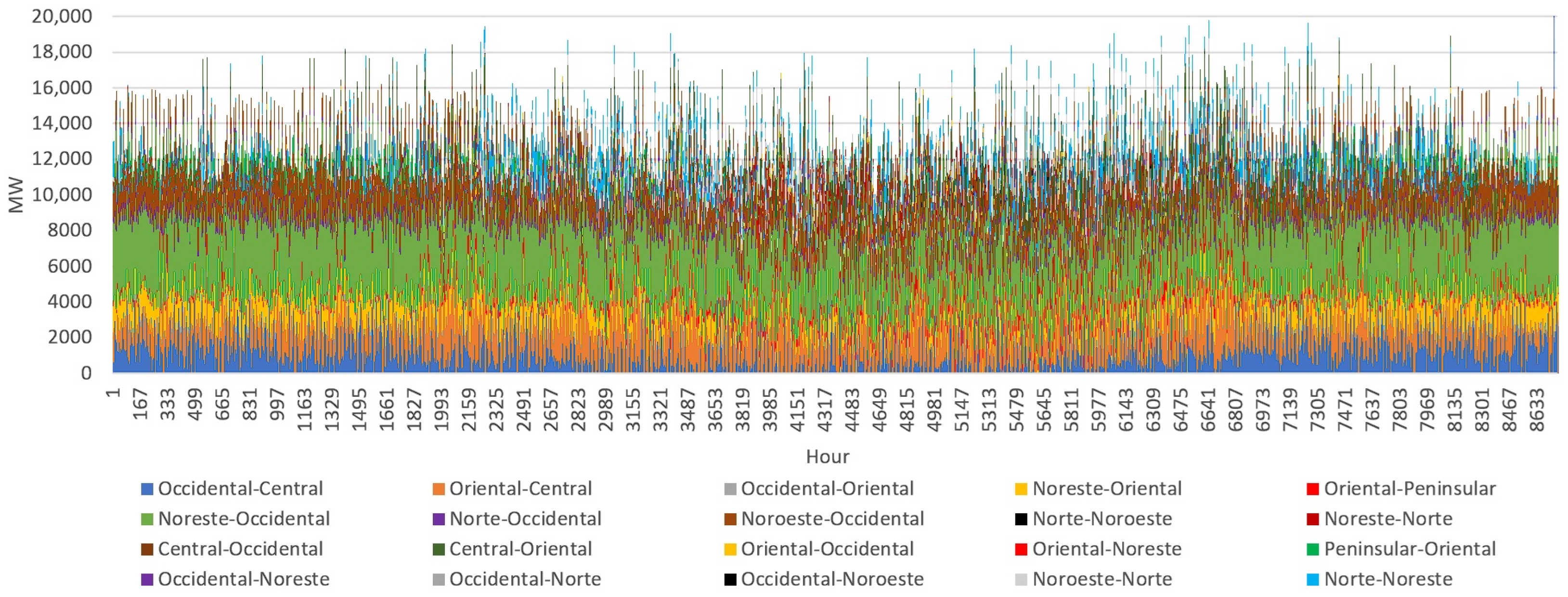
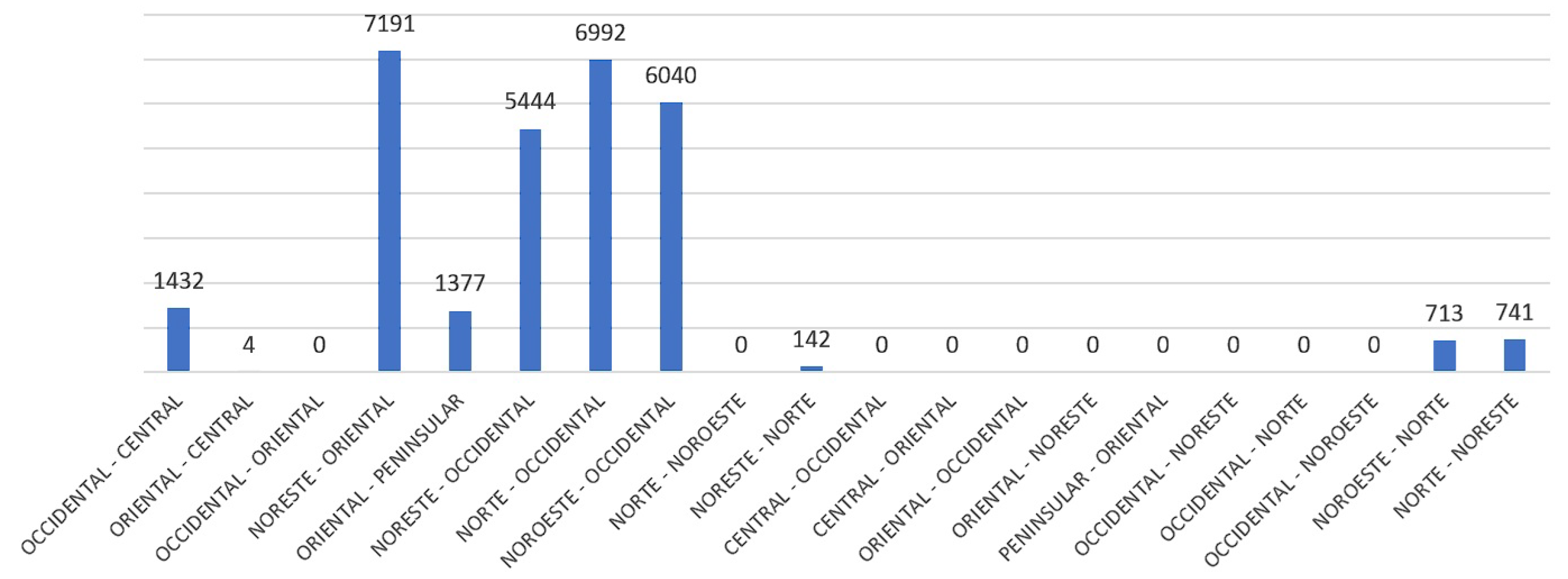
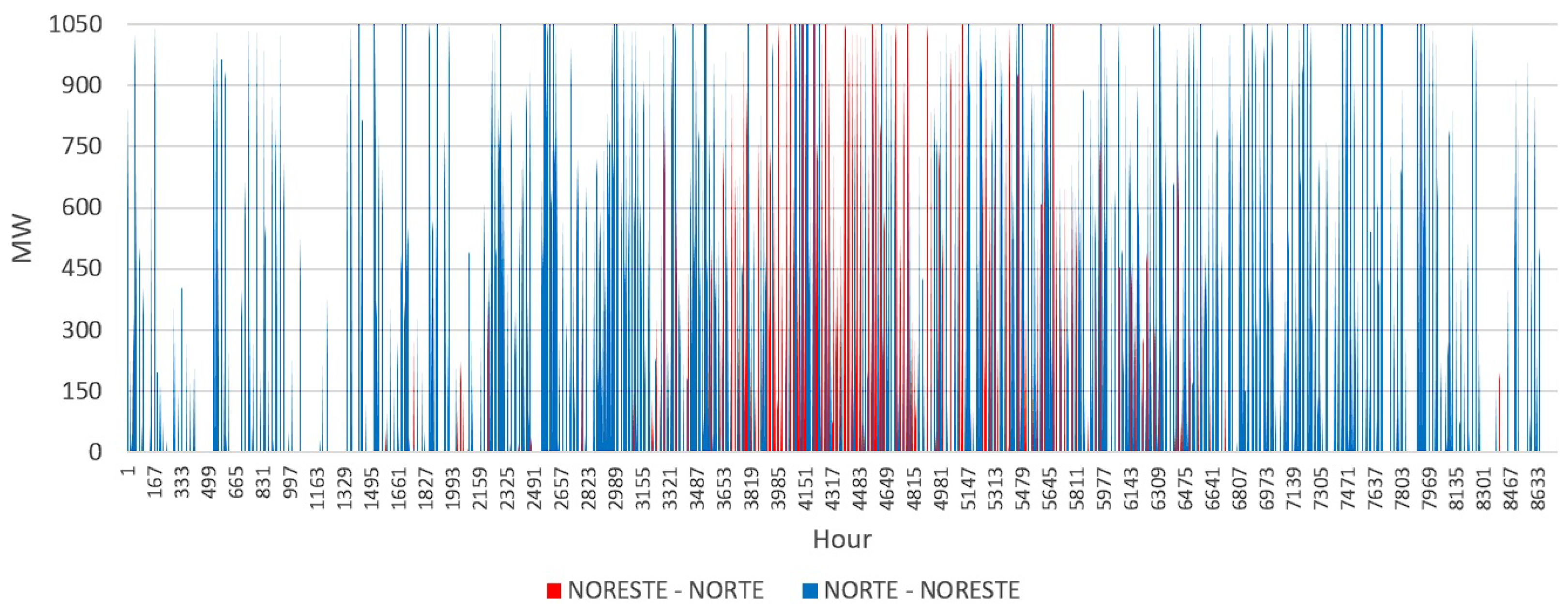
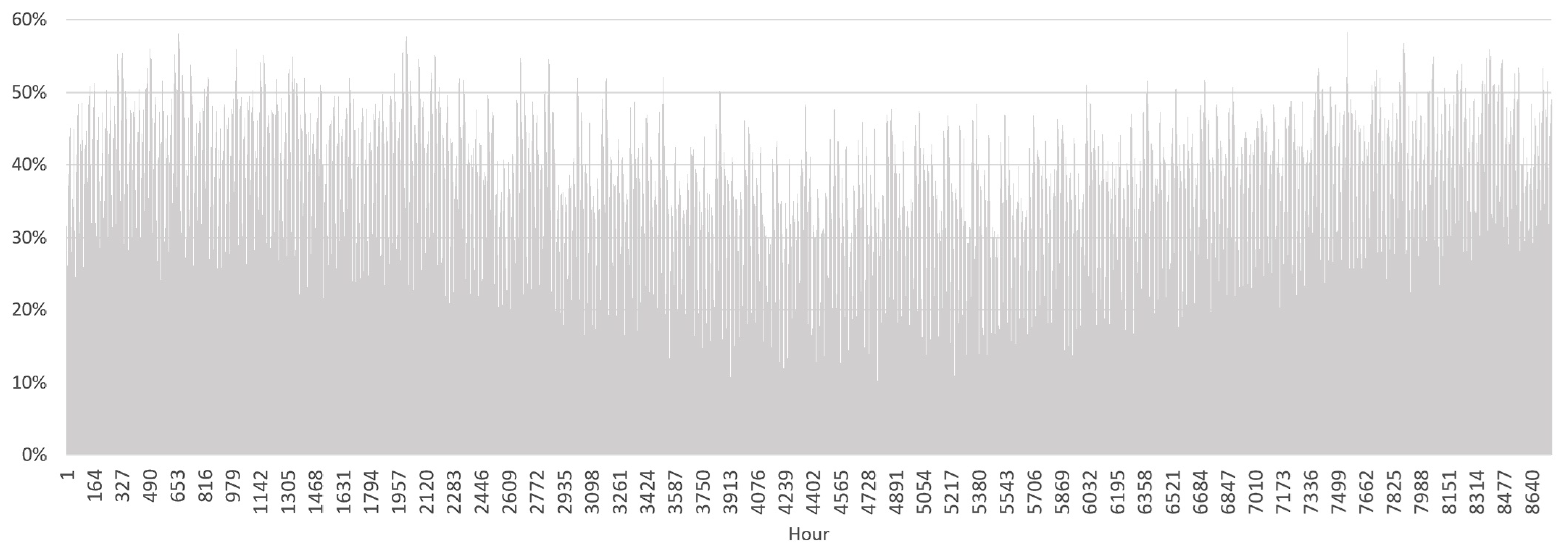




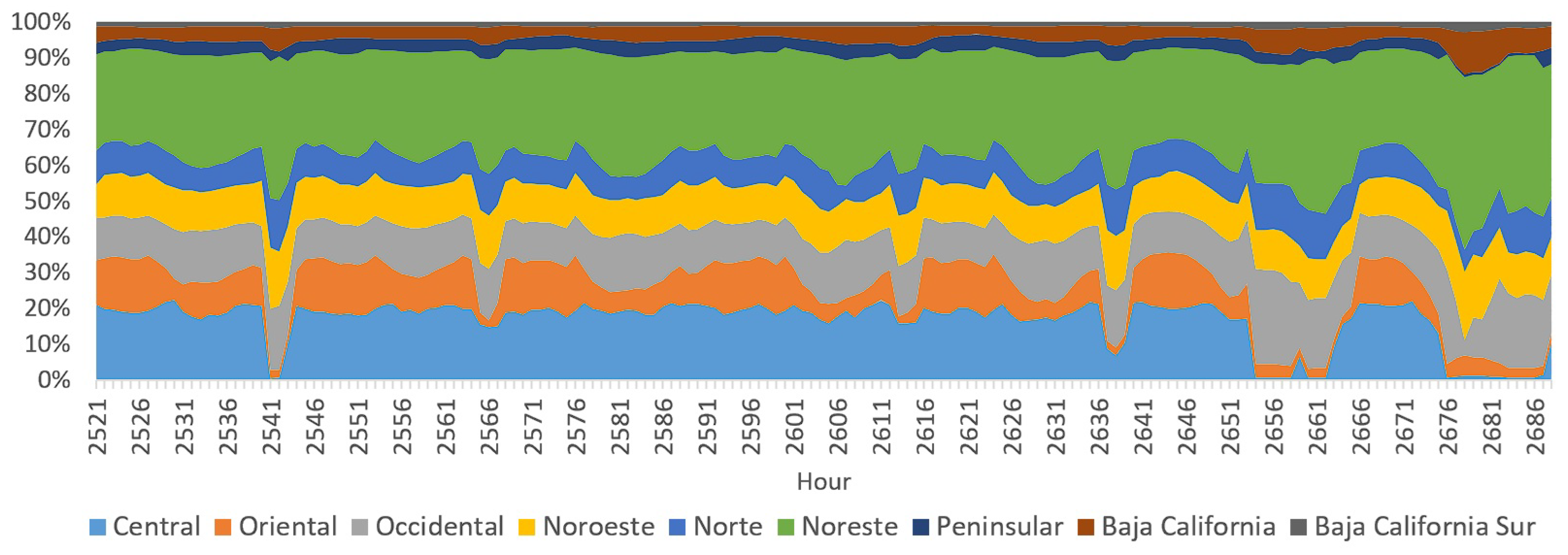

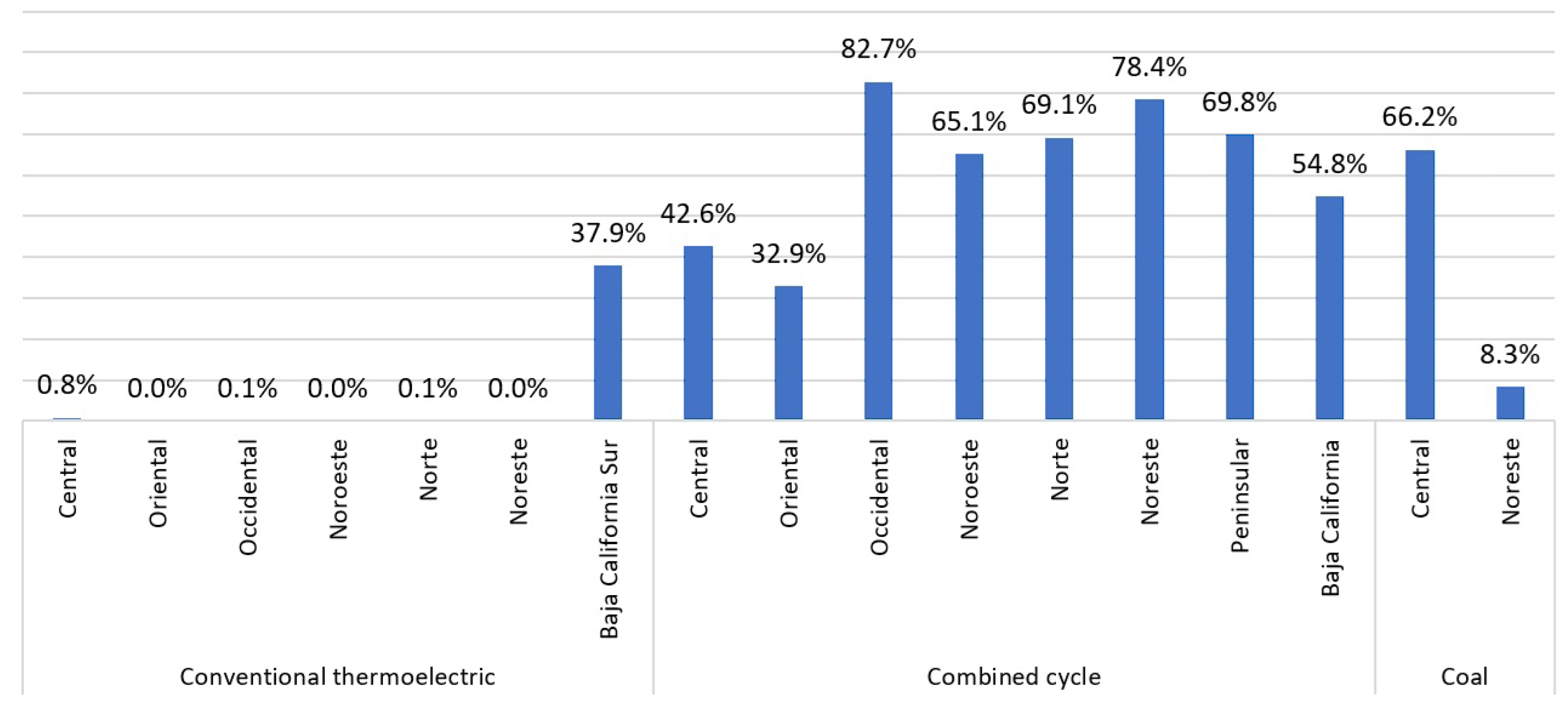
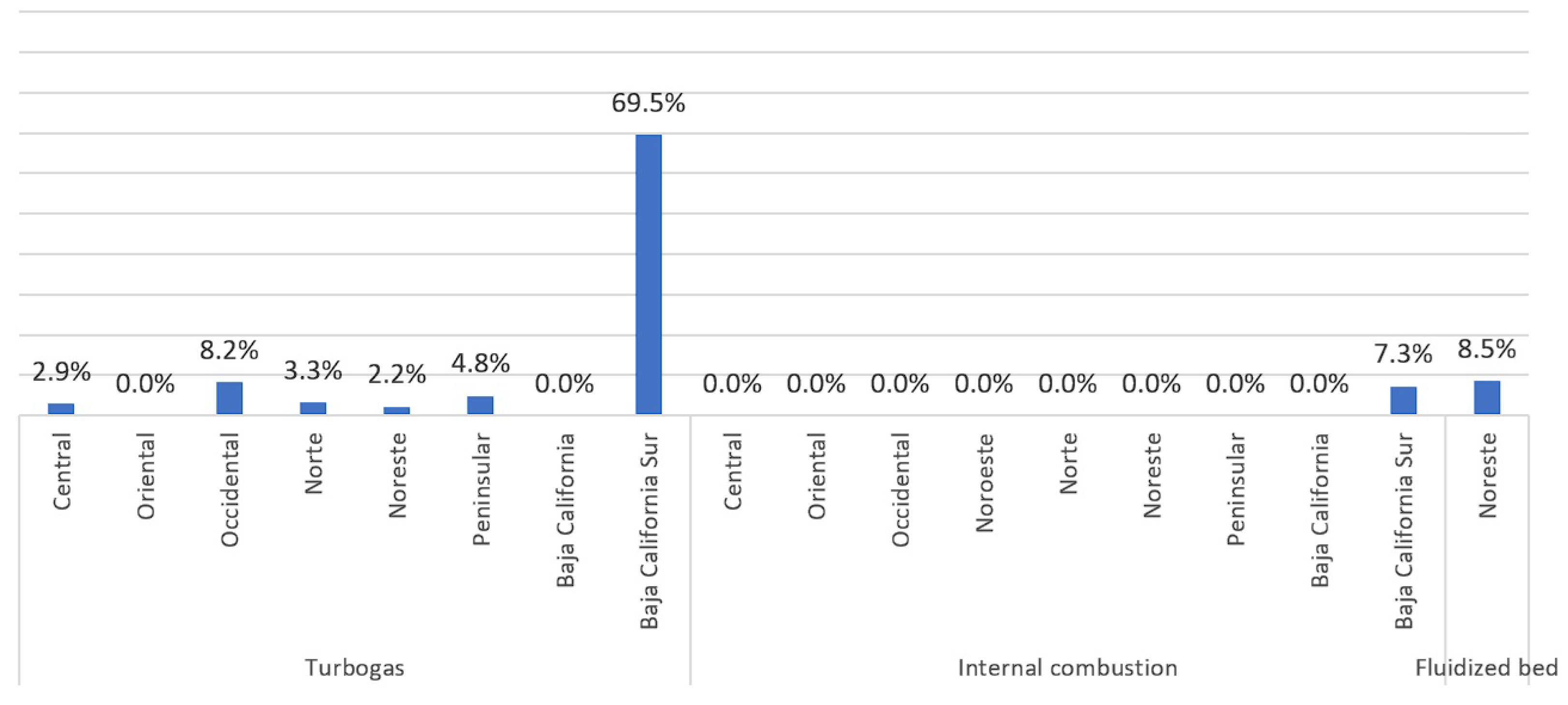
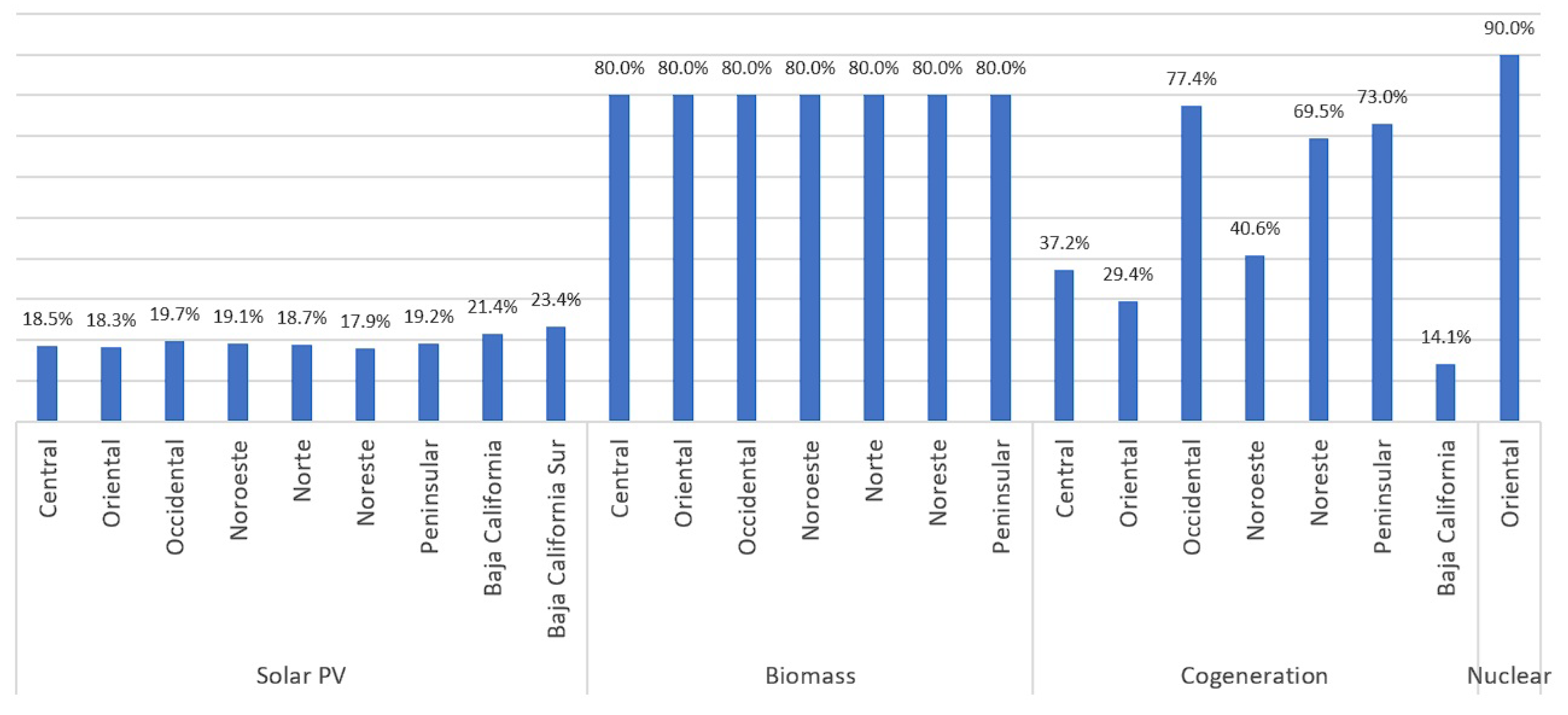
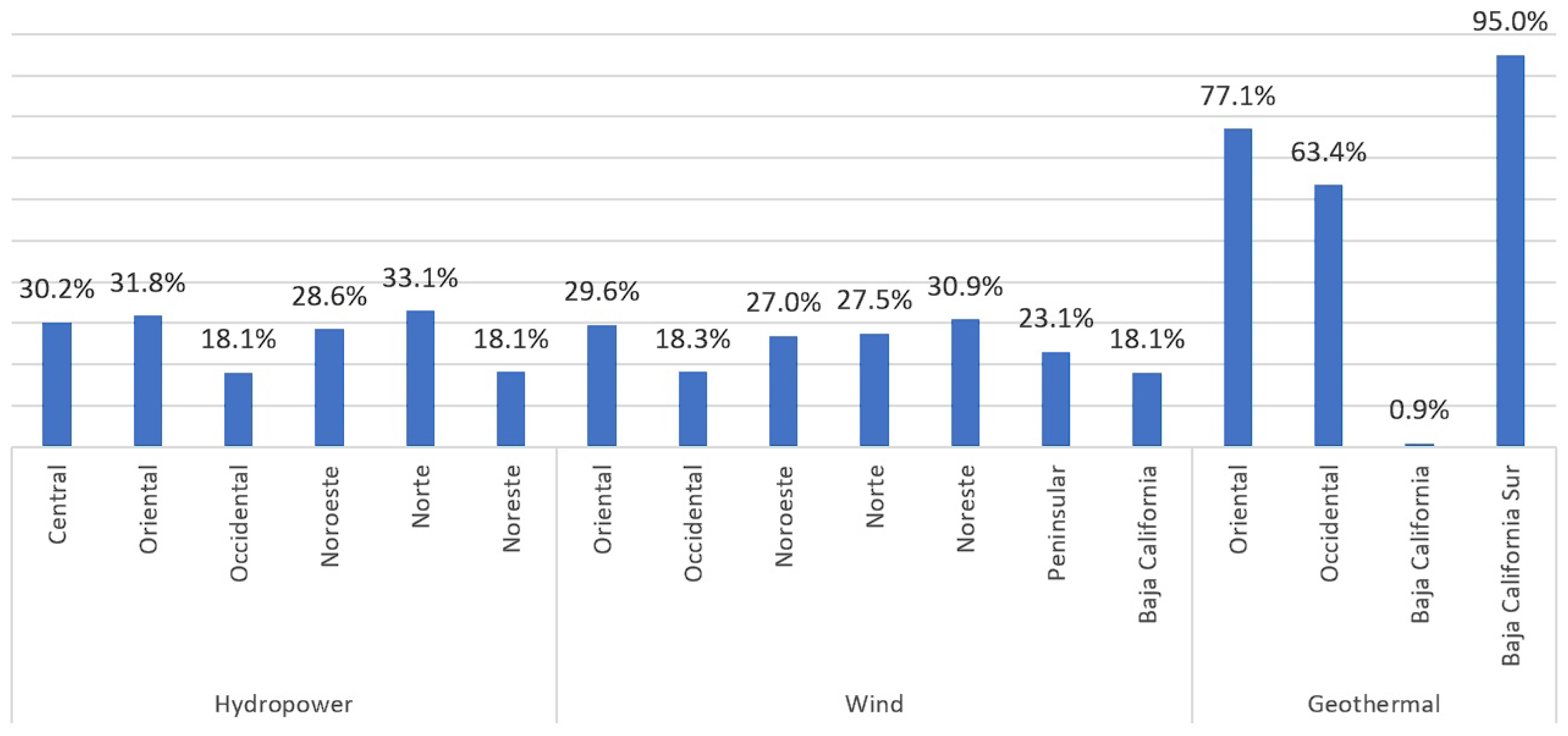
| Parameter/Variable | Sets | Number of Values | |||
|---|---|---|---|---|---|
| Technologies (13) | Generation Region (9) | Consumption Region (9) | Time Steps (8760) | ||
| Cost | X | X | X | X | 9,224,280 |
| Demand | X | X | 78,840 | ||
| Availability factor | X | X | X | 1,024,920 | |
| Installed capacity | X | X | X | 1,024,920 | |
| Transmission capacity | X | X | X | 709,560 | |
| Energy dispatch | X | X | X | X | 9,224,280 |
Disclaimer/Publisher’s Note: The statements, opinions and data contained in all publications are solely those of the individual author(s) and contributor(s) and not of MDPI and/or the editor(s). MDPI and/or the editor(s) disclaim responsibility for any injury to people or property resulting from any ideas, methods, instructions or products referred to in the content. |
© 2025 by the authors. Licensee MDPI, Basel, Switzerland. This article is an open access article distributed under the terms and conditions of the Creative Commons Attribution (CC BY) license (https://creativecommons.org/licenses/by/4.0/).
Share and Cite
Hernandez-Hurtado, U.; Medina-Marín, J.; Seck-Tuoh-Mora, J.C.; Hernández-Romero, N.; Martin-del-Campo, C. An Analysis to Identify the Key Factors in Power System Planning: The Case of Mexico. Energies 2025, 18, 1316. https://doi.org/10.3390/en18061316
Hernandez-Hurtado U, Medina-Marín J, Seck-Tuoh-Mora JC, Hernández-Romero N, Martin-del-Campo C. An Analysis to Identify the Key Factors in Power System Planning: The Case of Mexico. Energies. 2025; 18(6):1316. https://doi.org/10.3390/en18061316
Chicago/Turabian StyleHernandez-Hurtado, Ulises, Joselito Medina-Marín, Juan Carlos Seck-Tuoh-Mora, Norberto Hernández-Romero, and Cecilia Martin-del-Campo. 2025. "An Analysis to Identify the Key Factors in Power System Planning: The Case of Mexico" Energies 18, no. 6: 1316. https://doi.org/10.3390/en18061316
APA StyleHernandez-Hurtado, U., Medina-Marín, J., Seck-Tuoh-Mora, J. C., Hernández-Romero, N., & Martin-del-Campo, C. (2025). An Analysis to Identify the Key Factors in Power System Planning: The Case of Mexico. Energies, 18(6), 1316. https://doi.org/10.3390/en18061316












